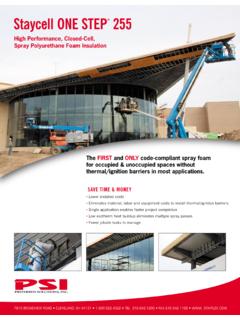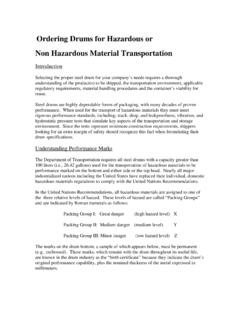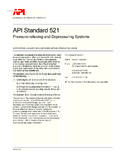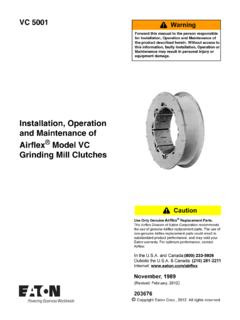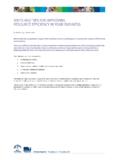Transcription of Material Safety Data Sheet - Stayflex
1 Material Safety data Sheet MSDS Code: Staycoat 2510 Page 1 Date Revised: 05/26/09 ---------------------------------------- ---------------------------------------- ------------------------------------- SECTION I CHEMICAL PRODUCT AND COMPANY IDENTIFICATION Product Name: Staycoat 2510 Gelcoat Topcoat Company Identification: Preferred Solutions, Inc. 7819 Broadview Road Cleveland, OH 44131 IN CASE OF EMERGENCY: Chemtrec (US): 24 hours/7days (800) 424-9300 Manufacturer: 9am-5pm (EST) Mon-Fri (800) 522-4522 SECTION II HAZARDOUS INGREDIENT INFORMATION Ingredient (s) CAS# % (by weight) Polymer (s) Trade Secret 53 Styrene Monomer 100-42-5 37 Additional Ingredient Information: Styrene Monomer may contain trace amounts of Benzene (CAS# 71-43-2) as an impurity.
2 This mixture is classified as hazardous under OSHA Hazard Communication Standard (29 CFR ). SECTION III HAZARDS IDENTIFICATION Potential Acute Health Effects: Inhalation of spray mist or liquid vapors may cause upper respiratory irritation and possible central nervous system effects including headaches, nausea, vomiting, dizziness, drowsiness, loss of concentration, impaired judgement and general weakness. Severe eye irritant may result in redness, burning, tearing and blurred vision. Skin irritant may result in redness, burning, drying and cracking or possible allergic skin reaction. Ingestion may result in mouth, throat, lung, gastrointestinal irritation and nausea, vomiting and diarrhea. Carcinogenic Effects: Styrene: Classified 2B (possible for human) by the International Agency for Research on Cancer (IARC). Various long-term animal studies and epidemiology studies of workers exposed to styrene do not provide a basis to conclude that styrene is carcinogenic.
3 Material Safety data Sheet MSDS Code: Staycoat 2510 Page 2 Date Revised: 05/26/09 ---------------------------------------- ---------------------------------------- ------------------------------------- SECTION IV - FIRST AID MEASURES Eyes: Move individual away from exposure and into fresh air. Flush with water for at least fifteen (15) minutes. Get prompt medical attention. Skin: Remove contaminated clothing. Wash thoroughly with soap and water. If skin is damaged seek immediate medical attention. If skin is not damaged and symptoms persist, seek medical attention. Launder clothing before reuse. Swallowing: Seek medical attention. If individual is drowsy or unconscious, do not give anything by mouth; place individual on the left side with the head down.
4 Contact a physician, medical facility or poison control center for advice about whether to induce vomiting. If possible, do not leave individual unattended. Inhalation: Move individual away from exposure and into fresh air. If symptoms persist, seek medical attention. If breathing is difficult, administer oxygen. Keep person warm and quiet; seek immediate medical attention. Note to Physicians: This Material is an aspiration hazard. Potential danger from aspiration must be weighed against possible oral toxicity when deciding whether to induce vomiting. Pre-existing disorders of the following organs may be aggravated by exposure to this Material : respiratory tract, skin, lung, liver, kidney, central nervous system, male reproductive system, auditory system. SECTION V FIRE FIGHTING MEASURES Auto-Ignition Temperature: 914oF (490oC) Styrene Flash Point: 88oF (31oC) Styrene Flammable Limits: Lower flammable limit of vapors: Styrene Monomer Upper flammable limit of vapors: Products of Combustion: May produce carbon dioxide, carbon monoxide, toxic fumes, and other hydrocarbons.
5 Fire and Explosion Hazards: Flammable liquid. Vapors are heavier than air and may travel along the ground or may be moved by ventilation and ignited by pilot lights, other flames, sparks, heaters, smoking, electric motors, static discharge or other ignition sources at locations distant from Material handling point. Never use welding or cutting torch on or near drum (even empty) because product (even just residue) can ignite explosively. Material Safety data Sheet MSDS Code: Staycoat 2510 Page 3 Date Revised: 05/26/09 ---------------------------------------- ---------------------------------------- ------------------------------------- Extinguishing Media: Foam (such as AFFF & AR), water fog, dry chemical, carbon dioxide Fire Fighting Instructions: Keep personnel removed and upwind of fire.
6 Wear self-contained breathing apparatus with a full facepiece operated in the positive pressure demand mode with appropriate turn-out gear and chemical resistant personal protective equipment. Polymerization will take place under fire conditions. If polymerization occurs in a closed container, there is a possibility it will rupture violently. Cool storage container with water, if exposed to fire. NFPA Rating: Health: 2 Flammability: 3 Reactivity: 2 SECTION VI ACCIDENTAL RELEASE MEASURES Small Spill: Eliminate all sources of ignition such as flares, flames (including pilot lights) and electrical sparks. Absorb liquid with vermiculite, floor absorbent or other absorbent Material . Person not wearing proper personal protective equipment should be excluded from area of spill. Large Spill: Eliminate all sources of ignition such as flares, flames (including pilot lights) and electrical sparks.
7 Absorb liquid with vermiculite, floor absorbent or other absorbent Material . Person not wearing proper personal protective equipment should be excluded from area of spill. Prevent runoff from entering drains, sewers or other waterways. If run-off occurs, notify proper authorities that a spill has occurred. SECTION VII HANDLING AND STORAGE Handling: Containers may be hazardous when emptied. Since emptied containers retain product residues (vapor, liquid, and/or solid), all hazard precautions given in the data Sheet must be observed. As with all products of this nature, good personal hygiene is essential. Avoid contact with eyes, skin and clothing. Avoid breathing vapor, mist or spray. Use with good ventilation. Wash hands thoroughly after handling. Storage: Store drums in a cool area and out of direct sunlight so Staycoat 2510 is maintained at 77 F or lower to avoid polymerization which will cause the Material to be unsuitable for use.
8 Shelf Life: Uncatalyzed Staycoat 2510 is stable for three (3) months when stored at 77 F or below in a closed, opaque container out of direct sunlight or other sources of heat. Do not add catalyst directly to the Staycoat in the drum. The catalyst must be incorporated as a separate component in accordance with specific application instructions. SECTION VIII EXPOSURE CONTROLS / PERSONAL PROTECTION Exposure Guidelines: STYRENE MONOMER (100-42-5) OSHA PEL PPM TWA OSHA PEL PPM CEILING Material Safety data Sheet MSDS Code: Staycoat 2510 Page 4 Date Revised: 05/26/09 ---------------------------------------- ---------------------------------------- ------------------------------------- POLYMER (S) No exposure limits established Respiratory Protection: Select NIOSH-approved respirators that provide adequate protection from the concentration levels encountered.
9 Use positive pressure, supplied-air respirators if there is potential for an uncontrolled release, if exposure levels are unknown or under circumstances where air-purifying respirators may not provide adequate protection. Reference OSHA 29 CFR 1910. Skin Protection: Wear chemical resistant gloves such as: polyvinyl alcohol. To prevent repeated or prolonged skin contact, wear impervious clothing. Replace as often as needed to maintain protection. Eye Protection: Use OSHA compliant chemical Safety goggles. Engineering Controls: Provide sufficient mechanical ventilation to maintain exposure below exposure limits. Use explosion proof motors and wiring. HMIS Hazard Rating: Health: 2 Fire: 3 Reactivity: 2 SECTION IX PHYSICAL AND CHEMICAL PROPERTIES Appearance: Viscous Color: White State: Liquid Boiling Point: 293 F (145 C) Styrene Vapor Pressure: mmHg @ 68 F (20 C) Styrene Specific Gravity: Odor/Threshold: Strong/Pungent.
10 Ppm Styrene SECTION X STABILITY AND REACTIVITY data Chemical Stability: Stable. Avoid heat, open flame and prolonged storage at elevated temperatures. Hazardous Polymerization: Hazardous polymerization may occur. Avoid exposure to excessive heat, peroxides and polymerization catalysts. Material Safety data Sheet MSDS Code: Staycoat 2510 Page 5 Date Revised: 05/26/09 ---------------------------------------- ---------------------------------------- ------------------------------------- Hazardous Decomposition: May form carbon dioxide, carbon monoxide, toxic fumes and other hydrocarbons. Incompatibility: Avoid contact with acids, aluminum chloride, amines, excessive heat, halogenated hydrocarbons, halogens, iron chloride, metal salts, peroxides, strong alkalis and strong oxidizing agents.


